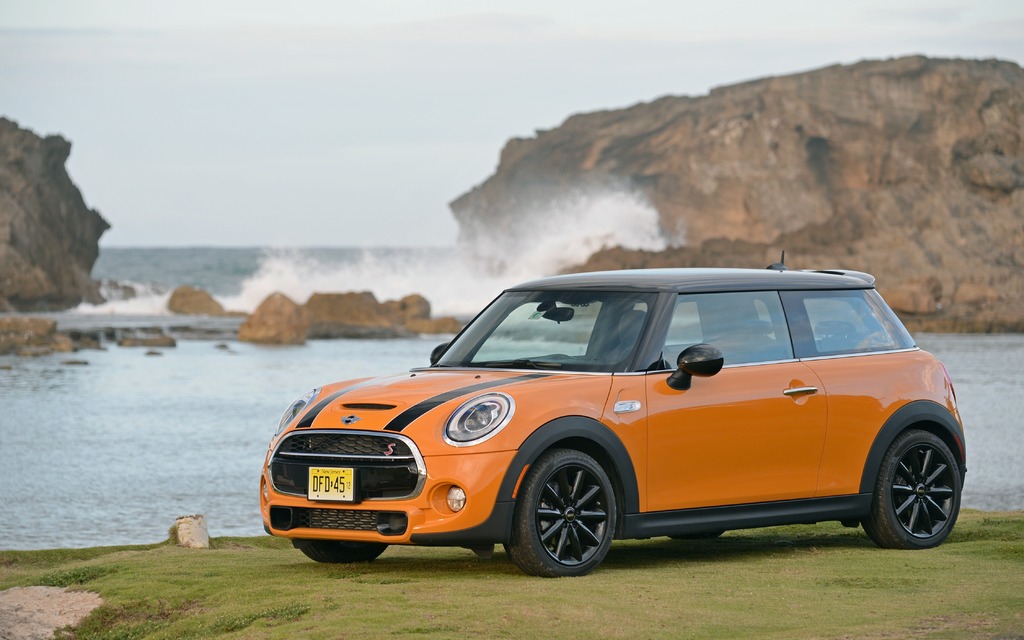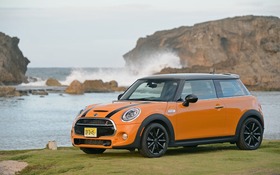2014 MINI Cooper: Decreasingly English!
As a car whose parents come from different backgrounds, the MINI Cooper has come a long way since its reincarnation in 2002. Its ancestor, the first MINI Cooper, was a pure Brit, but the second vehicle of the same name became increasingly German after the brand was purchased by BMW—which in no way prevented it from carving out a preferred place for itself among small cars. Over time, its family expanded greatly, with a whole host of versions being released. Christmases sure are merry at the MINI house.
The unique shape and size of the second MINI Cooper were reminiscent of the original English chap, but its German genes helped it shed its working-class past and move it into new social circles. Gone was the affordable little car with mass appeal; instead, it became a small luxury sports car with an exciting ride and multitude of gadgets. The MINI isn’t for everyone anymore.
- Also: MINI and Touring Superleggera Build a Sleek Roadster
- Also: Updates for the 2015 MINI Paceman and Countryman
Less and less mini
2014 brings the third generation of the model, which represents a significant evolution compared to the previous MINI. As the German influence has increased, so too has the vehicle’s size; it’s immediately obvious. Now 114 mm longer, 44 mm wider and 7 mm taller, the new MINI is gradually approaching the dimensions of a subcompact. Of course, this is to satisfy drivers who found it a little too mini and not versatile enough. The additional 50 litres of cargo capacity is what people really like. Sure, it still isn’t a minivan, but it’s better than before.
The multicultural drivetrain is a thing of the past too. This year, there are two new engines that come entirely from BMW—and both are turbocharged. The basic MINI features a 1.5-litre 3 cylinder twin-turbo with direct injection and 134 horsepower, some 13 more than the last generation. This is the first time this engine is being used at BMW/MINI, but it will soon be featured in the BMW i8, the new hybrid supercar.
The Cooper S also has a twin-turbo direct injection engine, but it’s a four-cylinder that produces 189 horsepower and an excellent torque rating of 207 lbs-ft. The good news is that the engines run on regular gasoline, even though they recommend super. The two available transmissions include the factory-standard six-speed manual (a veritable endangered species) that is lighter and staggered differently to maximize fuel economy. If stick shifts aren’t your cup of tea, there’s an optional six-speed automatic with controls behind the steering wheel that allow you to change gears manually. The MINI comes with front-wheel drive only, with the exception of the MINI Countryman, which can be equipped with all-wheel drive.
Prettier and prettier
The new MINI represents a real style evolution, while continuing to reflect its past. The front end has changed the most, featuring a new, larger grille. The classic round headlights can now be ordered with LED lamps. The roof remains elongated and flat while the tail end now has modified lights as well. Basically, the changes are numerous, but they don’t distort the car.
The most notable changes are on board, with the passenger compartment better reflecting the car’s asking price. For example, the numerous plastic panels feature a better finish. The dashboard is still classic, as its layout, gauges and commands are still a long way from the integrated design found in other cars. The small toggle-switch used to start the car is a perfect illustration of how we are moving away from traditional passenger compartments.
In the middle of the dashboard, the MINI’s signature oversize speedometer remains, but in a more modern form. At its centre, there’s an 8.8-inch colour screen that displays a wide variety of information. The idea to replace the controller with a more conventional scroll wheel to control the various elements of this system was a masterstroke. The speedometer is bordered by an LED band displaying different colours and feedback: for example, it turns green when you drive in an energy-efficient manner. The storage space is a little more generous and the room in the back seats has increased compared to the old generation.
On the road
The MINI isn’t just an extraordinary luxury car, it’s a lot of fun to drive, too. This little go-kart can be driven with your fingertips, and it remains glued to the pavement at all times. In fact, it’s a sweet ride for any racing enthusiast. Its compact size and very low centre of gravity make it agile while its reduced weight makes for exhilarating performances in spite of its minimalist engine capacity. The Cooper S goes from 0-100 km/hr in 6.7 seconds—not too shabby at all!
Of the two engines, the Cooper S’ 2.0-litre four-cylinder is the most intoxicating. Its superior torque makes both the acceleration and pick up more pleasant. But alas, we miss the initial oomph of the old turbocharged engine. When you engage Sport mode, the car “understands” that you want a more dynamic ride and, as a result, it adjusts several settings to maximize performance. It even makes the muffler backfire when you decelerate, which is a small but much appreciated detail.
The MINI Cooper’s new configuration pushes the wheels even further out to the car’s extremities, not only improving the space in the passenger compartment, but optimizing the car’s handling at the same time. The shape and feel of the steering wheel are worthy of a race car and the lateral support of the seats has been upgraded. All of this adds to the feeling of being in a small race car.
Normally, people get excited about the arrival of new generation models. In the case of the new MINI, we admit to feeling the thrill, even though we still have a soft spot for the older generations. That’s proof positive that the car is a classic! Its price will be unveiled at a later date, but you can bet your bottom dollar that the options catalogue will be another huge blow to the pocketbook.












